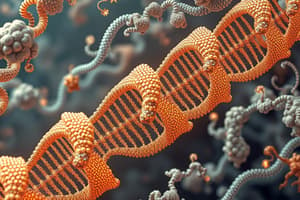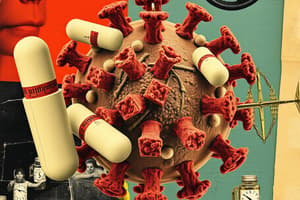Podcast
Questions and Answers
Which class of antibiotics inhibits protein synthesis by binding to the 50s ribosomal subunit near the surface interface of the 30s subunit?
Which class of antibiotics inhibits protein synthesis by binding to the 50s ribosomal subunit near the surface interface of the 30s subunit?
- Fluoroquinolones
- Aminoglycosides
- Macrolides (correct)
- Tetracyclines
Which mechanism of resistance involves altering the binding site of the ribosomal subunit to prevent antibiotic action?
Which mechanism of resistance involves altering the binding site of the ribosomal subunit to prevent antibiotic action?
- Alteration in binding site (correct)
- Efflux pumps
- Nullifying cell permeability
- Enzyme production
Which antibiotic class has the clinical use of treating atypical pathogens like Legionella and Chlamydia?
Which antibiotic class has the clinical use of treating atypical pathogens like Legionella and Chlamydia?
- Macrolides (correct)
- Penicillins
- Fluoroquinolones
- Cephalosporins
Which antibiotic has the potential side effect of causing QT prolongation and C. difficile infection?
Which antibiotic has the potential side effect of causing QT prolongation and C. difficile infection?
Which enzyme inducer can decrease the plasma concentration of Linezolid?
Which enzyme inducer can decrease the plasma concentration of Linezolid?
Which antibiotic class inhibits folate synthesis by competitively antagonizing p-Aminobenzoic acid (PABA)?
Which antibiotic class inhibits folate synthesis by competitively antagonizing p-Aminobenzoic acid (PABA)?
What is the mechanism of action of 30s ribosomal inhibitors?
What is the mechanism of action of 30s ribosomal inhibitors?
Which resistance mechanism involves altering the binding site of the ribosomal subunit?
Which resistance mechanism involves altering the binding site of the ribosomal subunit?
What is the spectrum of activity for Tetracycline and Tigecycline?
What is the spectrum of activity for Tetracycline and Tigecycline?
Which drug is indicated for treating Hepatic Encephalopathy?
Which drug is indicated for treating Hepatic Encephalopathy?
What is a common side effect associated with 30s ribosomal inhibitors?
What is a common side effect associated with 30s ribosomal inhibitors?
Which bacteria are NOT typically sensitive to Tetracycline and Tigecycline?
Which bacteria are NOT typically sensitive to Tetracycline and Tigecycline?
Flashcards are hidden until you start studying
Study Notes
30S Ribosomal Inhibitors
- Aminoglycosides: bactericidal, inhibit protein synthesis by changing the shape of the 30S portion and causing incorrect reading of the mRNA code
- Examples: Gentamicin, Tobramycin, Neomycin, Amikacin, Streptomycin
- Tetracycline: bacteriostatic, inhibits attachment of tRNA to mRNA-ribosome complex
- Examples: Doxycycline, Minocycline, Tetracycline, Tigecycline
- Resistance mechanisms:
- Alteration in binding site of ribosomal subunit
- Nullifying cell permeability to drug
- Efflux pumps
- Enzyme produced to inactivate drug (transferase/erm)
- Pharmacokinetics/Pharmacodynamics (PKPD):
- Concentration-dependent: >10x above MIC for best response
- AUC/MIC ratio is important
- Highly polar, difficult to penetrate cell wall
- Half-life: 1.5-3.5 hours
- Time-dependent for Tetracycline and Tigecycline
- Spectrum:
- Streptococcus, Staphylococcus aureus, Listeria, Enterococcus (VRE/MRSA)
- Not effective against Neisseria, Moraxella, Hemophilus, and atypical bacteria (Legionella, Mycoplasma, Chlamydia, Rickettsia)
- Clinical uses:
- Streptococcal and TB infections
- Neomycin: hepatic encephalopathy
- Spectinomycin: resistant gonococcal infections
- Gentamicin: sepsis, pneumonia
- Tetracycline: atypical pneumonia, mycoplasma, acne, H. pylori, malaria, and chlamydia
- Side effects:
- Ototoxicity (irreversible)
- Nephrotoxicity
- Neuromuscular blockade (NMB)
- Risk: Myasthenia gravis, hypocalcaemia, hypomagnesemia
- Deposition of drug in bones and teeth
- GI disturbance, liver failure, vertigo, phototoxicity
- X: pregnant
- Drug-drug interactions (DDI): Nephrotoxic with Amphotericin B, vancomycin, and NSAIDs
50S Ribosomal Inhibitors
- Macrolides, Lincosamides, and Oxazolidinones: inhibit protein synthesis by binding to the 23S subunit of the 50S ribosome
- Examples: Erythromycin, Azithromycin, Clarithromycin, Clindamycin, Linezolid
- Resistance mechanisms:
- Alteration in binding site of ribosomal subunit
- Nullifying cell permeability to drug
- Efflux pumps
- Enzyme produced to inactivate drug (transferase/erm)
- MOA: Inhibits protein synthesis by binding to the 50S ribosomal subunit near the surface interface of the 30S subunit
- PKPD: Time-dependent, AUC/MIC ratio is important
- Spectrum:
- Streptococcus, Staphylococcus aureus, Listeria, Moraxella, Hemophilus
- Atypical bacteria: Legionella, Mycoplasma, Chlamydia, Rickettsia
- Clinical uses:
- Community-acquired pneumonia, Corynebacterial, Chlamydial infections
- Anaerobes: Bacteroides, Peptostreptococcus, Propionibacterium
- Skin and soft tissue infections, DM foot ulcers
- Prophylaxis in HIV patients
- Side effects:
- GI disturbance
- Thrombophlebitis
- QT prolongation
- GI diarrhea and nausea
- C. difficile infection
- Myelosuppression (thrombocytopenia, anemia)
- Monoamine oxidase inhibition (serotonin syndrome)
- Lactic acidosis
- Peripheral and optic neuropathy
- DDI: Simvastatin, carbamazepine, ciclosporin (increased levels)
- Digoxin (increased levels)
- NMB, MAOI, SSRI, tyramine-rich foods, adrenergic agents
- Rifampicin (induces CYP450 enzymes)
Folate Synthesis Inhibitors
- Sulphonamides and Trimethoprim: bacteriostatic, inhibit dihydropteroate synthase
- Examples: Sulphamethoxazole (SMZ), Sulphadiazine, Trimethoprim (TMP)
- MOA: Competitively antagonize PABA
- Resistance mechanisms:
- Alteration in binding site of dihydropteroate synthase
- Nullifying cell permeability to drug
- Efflux pumps
- Enzyme produced to inactivate drug (transferase/erm)
- PKPD: Time-dependent, AUC/MIC ratio is important
- Spectrum:
- Gram-positive and gram-negative bacteria
- Not effective against Pseudomonas and Candida
- Clinical uses:
- Urinary tract infections
- Prophylaxis in HIV patients
- Side effects:
- GI disturbance
- Allergic reactions
- Hematological disorders (thrombocytopenia, anemia)
- Hepatotoxicity
- Stevens-Johnson syndrome
- Toxic epidermal necrolysis
Studying That Suits You
Use AI to generate personalized quizzes and flashcards to suit your learning preferences.





